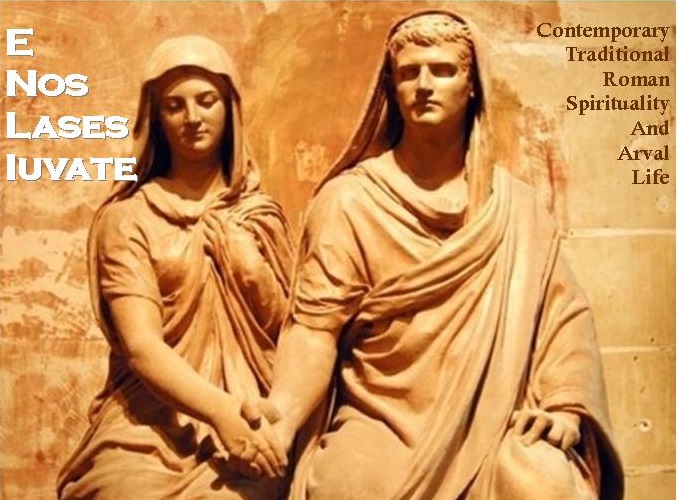A friend, Cultrix and good blogger suggested some comments regarding my previous post on Lararium and Worship of the Ancestors. These observations can be found as a comment to this previous post.
In brief she reflected about the issue of how can we place within the Cult of the
Ancestors, some Ancestors of a family who should not be mentioned for virtue
being negative individuals, unworthy of
admiration and even less of veneration.
The
question of course is linked to some foundamental topics such as the ratio
of the Cult of the Ancestors and the Dead, the concept of veneration or the same concept of worship.
To
understand the meaning that Tradition and the Traditional
Roman Spirituality gives to these issues is important to move, to "translate" our thoughts on
another level of reflection: Our plan of reflection must be symbolic, mythical, esoteric, deeper.
When
we speak of Ancestors we do not refer to them in a well defined "personal data" of a given person, in
biological, physical, material terms, but in mythical and
symbolic sense.
The concept of Ancestor, as well as that of the successor, highlights the idea of a chain, a transmission, a Tradition (tradere) in the most literal sense of the term, a movement, a continuing changing, a flowing, a walk along a path, a relay race, a Via.
Ancestors
in particular are those who started this chain, those who have been
(mythically) closer to the Gods and Goddesses during the progress of the
(mythical) ages: they are those who have initiated the mos maiorum. Death and the Ancestors are elements of the narrative of a spiritual feeling, which now becomes "our" own personal spiritual sentiment. Although
in the time course we had Ancestors who professed a religion totally
different from ours (ie Christian), they can be
organized within our inner spiritual Temple, according to our spiritual beliefs. Therefore they are part of the our family metaphysical order of the Afterlife which we now refer to.
In this perspective the concept of tradition, transmission, stability, order, hierarchy, structure, relationship acquire their value and meaning. Respect for parents, and their memory as Ancestry, is thus a critical contribution to create the basis of any social organization.
Furthermore, without this mythical and symbolic perspective, death would remain only a mere physical disintegration: in this way it acquires a value. Worship of Ancestors is therefore a response to the problem of death: even our death. The Lararium highlights this separation and this relationship between the world of the living and the dead and the unborn.
None
of us, even if belonging to an ancient family, may have memory of all
his/her ancestors, but what matters is to have a form of respect and awareness of our place in the course of the Sacred Time (which is not just a random flowing of events), a respect for those who have generated us, who gave us life, that have
gone before us. The
Traditional Roman Spirituality is not a religion, but it is a journey, a
path, and this concept of path and journey can be also applied to the idea of the
relationship between the past, present and future generations. The Traditional Roman Spirituality is a journey on a climb because it is also a Way of elevating; what
the Cultor and Cultrix are called to do is elevating themselves also
elevating his/her family (in a broad sense) or by highlighting the best,
the best ethical and spiritual qualities that can be found within this
family. The concept of pietas also embraces the idea of cultivating Gods and Goddesses on the basis of the virtus of the Ancients or of our Ancestors. The Cultor and Cultrix, through the pietas, are on the Way and by their ethical way of life they pass positive well defined values to the future generations. But we must not forget that "children are the censors of parents": an unjust parent does not deserve obedience of the children. An unjust parent, being as such, does not practice the pietas, he/she is not on the Via. He/she loses his/her authority in this life and he/she also loses his/her symbolic authority in death through the oblivion.
The Cultor and Cultrix, practicing the pietas,
have this awareness instead: they live to build and develop this symbolic
chain, acting to strengthen the idea of family roots to be transmitted
to their children. In this way, they become not only Cultor and Cultrix, but also a Pater and a Mater Familias.
Tradition
tells us, in a mythical and symbolic way, about the dead and the peaceless dead, about specific days when the dead could
symbolically meet the living members of the family, about purification rites of the dead, rituals to appease the peaceless dead that harass the living family. This
mythical and ritual structure shows that for the Ancients the aggregation
process of the deceased with the Ancestors follows a symbolic pace similar to the aggregation
process an individual has in the society of the living mankind. The deceased does not automatically enter the sphere of the Ancestors because this process requires complex "rites of the memory". To become a new Ancestor, the deceased must
be purified by the rites that have the primary purpose to remove his individual identity: he becomes so vague to be mingled together with all
others Ancestors. The identity of the individual Ancestry vanishes, his/her uniqueness is lost. The "veneration", the worship becomes a process of attributing global symbolic authority to the Ancestors as a whole, as an unique specific entity of a given family.
With
the cult of the Ancestors, we affirm the value of the idea that the
Cultor and Cultrix have for their "roots"(in the mythical,
symbolic, esoteric sense) in space and time: just like a big tree affirms her
force towards the sky thanks to her sound roots.




